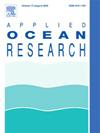Monte-Carlo simulation method for ship collision avoidance performance considering various encounter situations in port congestion zones
IF 4.4
2区 工程技术
Q1 ENGINEERING, OCEAN
引用次数: 0
Abstract
As interest in autonomous maritime technology continues to grow, various collision avoidance algorithms for autonomous vessels have been developed. However, evaluating and comparing the performance of these algorithms presents challenges due to the significant influence of factors such as the number of obstacles, specific encounter scenarios and obstacle arrangements. To address these challenges, the present study employs a Monte Carlo simulation technique to quantitatively evaluate the performance of ship collision avoidance algorithms in port congestion zones. To accurately reflect the conditions of real congested harbor areas with high ship traffic, four major encounter scenarios were defined, with the positions, velocities, and heading angles of obstacles randomly generated within predefined ranges to incorporate randomness into the simulation environment. Using the developed Monte Carlo simulation technique, the performance of the Worst Case Velocity Obstacle (WVO) algorithm and a hybrid algorithm combining WVO with modified Artificial Potential Field algorithm(APF) were qualitatively evaluated. The simulation results revealed the limitations of the WVO algorithm, particularly in scenarios involving crossing and converging encounters, due to frequent heading changes and passive rudder actions. In contrast, the hybrid algorithm, which incorporate WVO algorithm with modified APF method, demonstrated improved collision avoidance performances, including maintaining greater safe distance and reducing collision occurrence through actively using rudder angles.
考虑港口拥堵区各种遭遇情况的船舶避碰性能蒙特卡罗仿真方法
随着人们对自主海事技术的兴趣不断增长,各种自主船舶的避碰算法已经被开发出来。然而,由于障碍物数量、特定遭遇场景和障碍物布置等因素的显著影响,对这些算法的性能进行评估和比较具有挑战性。为了解决这些挑战,本研究采用蒙特卡罗模拟技术定量评估港口拥堵区域船舶避碰算法的性能。为了准确反映船舶流量大的真实拥挤港区的情况,定义了四种主要的遭遇场景,障碍物的位置、速度和航向角在预定义的范围内随机产生,将随机性融入模拟环境。利用蒙特卡罗仿真技术,对最坏情况速度障碍(WVO)算法以及WVO与改进人工势场算法(APF)相结合的混合算法的性能进行了定性评价。仿真结果显示了WVO算法的局限性,特别是在涉及交叉和收敛相遇的情况下,由于频繁的航向变化和被动的方向舵动作。相比之下,将WVO算法与改进的APF方法相结合的混合算法具有更好的避碰性能,包括通过主动利用方向舵角保持更大的安全距离和减少碰撞发生。
本文章由计算机程序翻译,如有差异,请以英文原文为准。
求助全文
约1分钟内获得全文
求助全文
来源期刊

Applied Ocean Research
地学-工程:大洋
CiteScore
8.70
自引率
7.00%
发文量
316
审稿时长
59 days
期刊介绍:
The aim of Applied Ocean Research is to encourage the submission of papers that advance the state of knowledge in a range of topics relevant to ocean engineering.
 求助内容:
求助内容: 应助结果提醒方式:
应助结果提醒方式:


